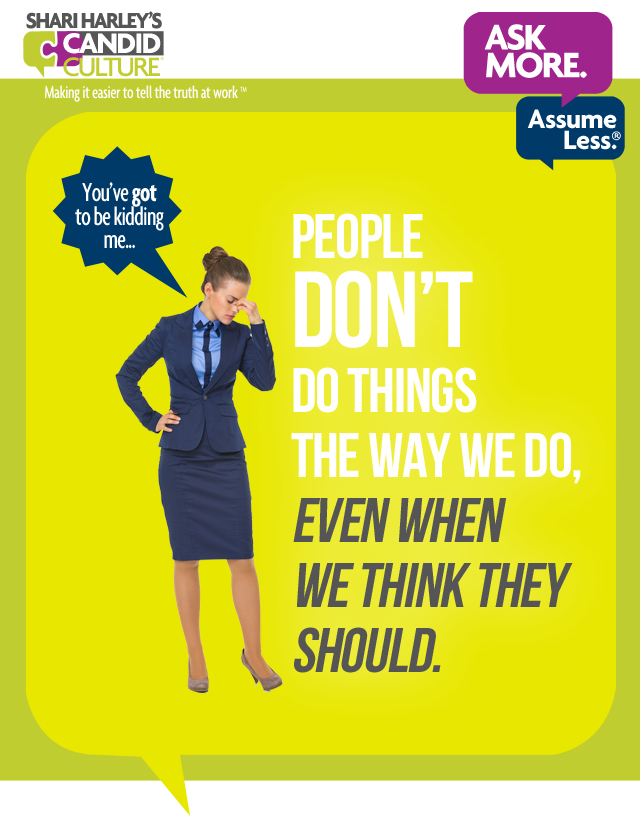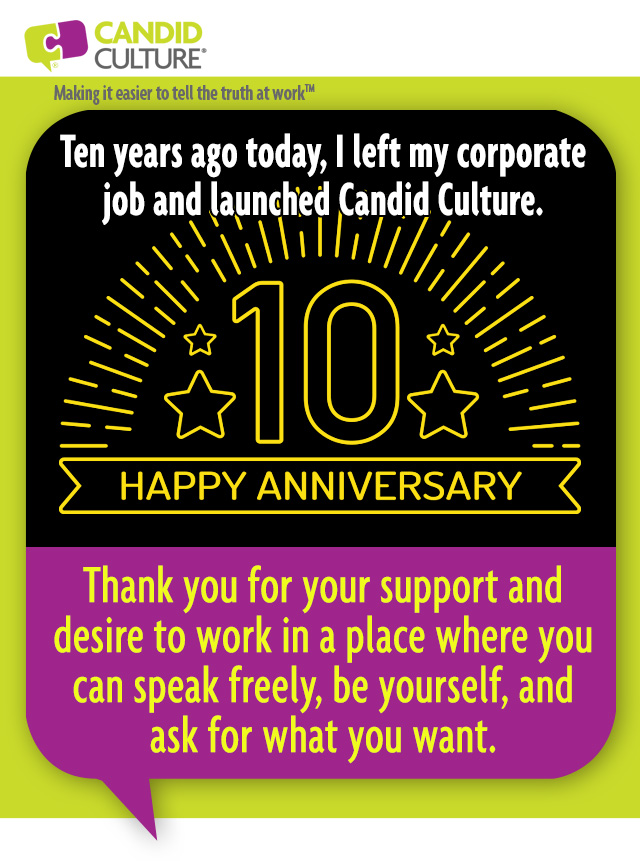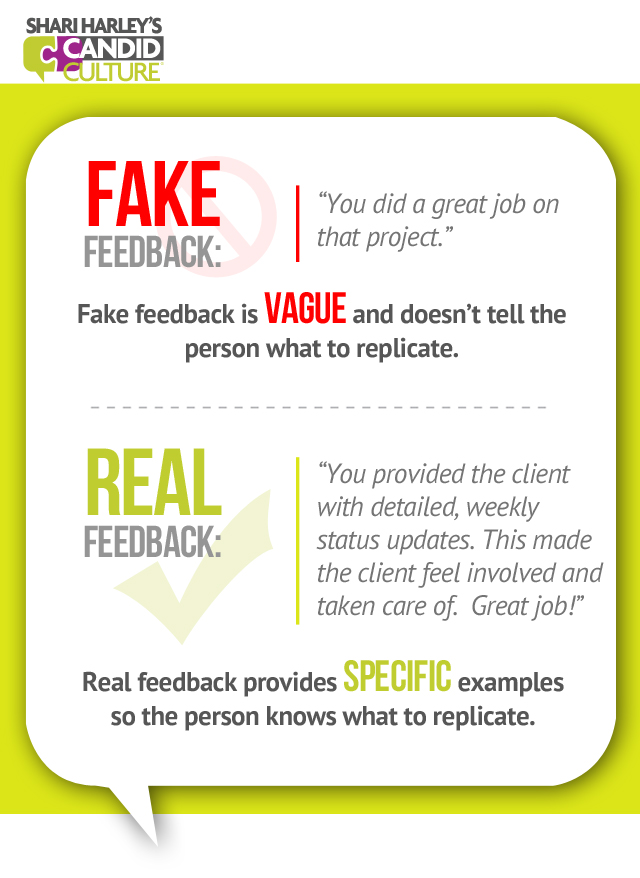Posts Tagged ‘feedback training’
People are not us; they do things their way, not ours. This is so obvious. Yet violated expectations are consistently a source of lots of frustration and upset, both personally and professionally. “How could you not check your work before submitting information to a client?” “What do you mean you didn’t call that person back?” “You said what?!”
The most frequent request we get at Candid Culture is for feedback training. The call usually goes something like this, “The  communication isn’t great at our company. Managers don’t give a lot of feedback. People don’t talk directly to each other when there are problems, they talk about each other. Can you help?”
communication isn’t great at our company. Managers don’t give a lot of feedback. People don’t talk directly to each other when there are problems, they talk about each other. Can you help?”
Sure, we can help. But once we’re having this conversation people are already frustrated. Trust has been violated and relationships and reputations have been damaged. Instead of waiting for problems to occur, expect the unexpected. Set clear expectations before people don’t proofread reports, miss deadlines, and do other things you wouldn’t dream of doing.
How to avoid violated (often unstated) expectations? Ask more questions.
Here are five questions you should ask every person you work with to set expectations. And if you do, your workplace will have fewer frustrations and violated expectations:
- What’s most important that you’re working on right now? What are your goals this quarter?
- What are we both working on that we can work on together? Or what should one of us stop working on?
- How do you like to communicate? Phone, in-person, by appointment or drop by’s.
- How do you like to receive information – email, voicemail, text message or instant messenger?
- If I need information from you and I haven’t heard back from you, what should I do, and is it ok to do that?
- What are your pet peeves at work? How will I annoy you and not even know it?
- How do you like to be interrupted? (You’re going to be interrupted. You might as well have a preference.)
I know. That was seven questions, not five. I could keep going. But this is a good start.
Here’s the philosophy and practice: People aren’t you. Anticipate challenges, breakdowns, and violated expectations, and talk about them before they happen. Make requests. Ask questions.
It’s always easier to ask for what you want than to give feedback.


Ten years ago today I left my corporate job and launched Candid Culture, business communication training. I’ll admit to being terrified and being pretty convinced I would fail. I thought about starting the business for 12 years, but was paralyzed by fear. The only thing that finally motivated me to act, was that at the time, I worked for someone who didn’t believe me when I said I didn’t want the internal opportunity he was giving me. Don’t give a woman who can barely use Excel, leadership over the Finance department.
The training and keynote speaking I do have evolved over the past ten years, as organizations’ needs have changed. A few things have remained constant.
Here’s what I’ve learned in the past ten years:
- People struggle more than I ever realized when receiving negative feedback. People care about the work they do, want to do a good job, and want to be thought well of. Negative feedback calls all of that into question.
Most people question themselves when receiving negative feedback, and that’s a very painful process.
What do to: Give very small amounts of feedback at a time. Share one or two things the person can work on. More negative information sends our brains to a dark place, where we feel we can’t be successful, and performance actually drops.
Provide feedback on the positive changes or lack thereof, that you see. Don’t let people work in a vacuum. After you’ve seen some improvement, give one or two additional pieces of feedback.
- Most of us get almost no feedback at work – positive or negative. “Good job” doesn’t qualify as feedback. But that’s almost all the ‘feedback’ most people get.
- Even if you ask for feedback, you probably won’t get much, because the other person is concerned about your potential negative reaction.
- Managers are afraid employees will quit if they give negative feedback or report them to HR or the Union.
- People really want to know how they’re doing – good and bad – even if they don’t want to hear the message.
- Giving negative feedback requires courage and a trusting relationship, in which the feedback recipient trusts that the person’s motives are pure.
So what to do with all of this information? Be courageous and clear. Remember that the purpose of feedback is to be helpful. Care enough to be uncomfortable. Specific is helpful. Giving feedback will always be challenging. If you want to give less feedback, get better at making specific requests. You get what you ask for.


Most training programs about giving feedback focus on negative feedback, because giving negative feedback is hard and makes us uncomfortable. But most people aren’t any better at giving positive feedback.
Most of the positive feedback people get at work really isn’t feedback at all. It’s vague, fluffy, and unhelpful. Aka, Cap’n Crunch – sweet but useless.
“Great job.” “You’re awesome.” “You’re great to work with.” None of this qualifies as real feedback.
The purpose of positive feedback is to make people feel valued and appreciated and to get them to replicate a behavior. Telling someone, “great job” or “you’re doing great work” will make the person feel good (momentarily), but won’t tell her what to replicate. These phrases are vague, and vague positive comments come across as inauthentic at best and unhelpful at worst.
Here are a few examples of what I refer to as real vs. fake feedback:
Examples of positive feedback:
Fake feedback: “Great job.”
Real feedback: “You researched three vendors when making a proposal of who we should choose to manage our payroll operations. You included all the necessary information for us to make a decision and presented the information in a one-page table that was easy to read. Your work made it really easy to make a decision. Great job!”
Examples of positive feedback:
Fake feedback: “You’re really reliable.”
Real feedback: “I know that whatever I give you to do will get done the first time I ask and will be accurate. I don’t have to ask again or check your work. You check your work for typos and mistakes before submitting it.”
Examples of positive feedback:
Fake feedback: “You make my job easy.”
Real feedback: “Last week you noticed an invoice that didn’t seem accurate. You researched the invoice and got the mistake corrected before I even knew there was a problem. You make my job easy.”
Examples of positive feedback:
Fake feedback: “You’re awesome.”
Real feedback: “You always do what’s right for the company. Last week you called a vendor whose service has been spotty. You provided them with feedback and asked for their plan to improve their service levels. This added a lot of value to our organization.”
The guidelines for giving positive feedback are the same as giving negative feedback:
- Be specific.
- Give an example.
- Give feedback close to the time an event happens.
To give specific and meaningful positive comments, you will have to observe performance, and that takes time. But if you want someone to replicate a behavior, tell the person specifically what she did well.

People are not us; they do things their way, not ours. This is so obvious. Yet violated expectations are consistently a source of lots of frustration and upset, both personally and professionally. “How could you not check your work before submitting information to a client?” “What do you mean you didn’t call that person back?” “You said what?!”
The most frequent request we get at Candid Culture is for feedback training. The call usually goes something like this, “The  communication isn’t great at our company. Managers don’t give a lot of feedback. People don’t talk directly to each other when there are problems, they talk about each other. Can you help?”
communication isn’t great at our company. Managers don’t give a lot of feedback. People don’t talk directly to each other when there are problems, they talk about each other. Can you help?”
Sure, we can help. But once we’re having this conversation people are already frustrated. Trust has been violated and relationships and reputations have been damaged. Instead of waiting for problems to occur, expect the unexpected. Set clear expectations before people don’t proofread reports, miss deadlines, and do other things you wouldn’t dream of doing.
How to avoid violated (often unstated) expectations? Ask more questions.
Here are five questions you should ask every person you work with. And if you do, your workplace will have fewer frustrations and violated expectations:
- What’s most important that you’re working on right now? What are your goals this quarter?
- What are we both working on that we can work on together? Or what should one of us stop working on?
- How do you like to communicate? Phone, in-person, by appointment or drop by’s.
- How do you like to receive information – email, voicemail, text message or instant messenger?
- If I need information from you and I haven’t heard back from you, what should I do, and is it ok to do that?
- What are your pet peeves at work? How will I annoy you and not even know it?
- How do you like to be interrupted? (You’re going to be interrupted. You might as well have a preference.)
I know. That was seven questions, not five. I could keep going. But this is a good start.
Here’s the philosophy and practice: People aren’t you. Anticipate challenges, breakdowns, and violated expectations, and talk about them before they happen. Make requests. Ask questions.
It’s always easier to ask for what you want than to give feedback.

 communication isn’t great at our company. Managers don’t give a lot of feedback. People don’t talk directly to each other when there are problems, they talk about each other. Can you help?”
communication isn’t great at our company. Managers don’t give a lot of feedback. People don’t talk directly to each other when there are problems, they talk about each other. Can you help?”






